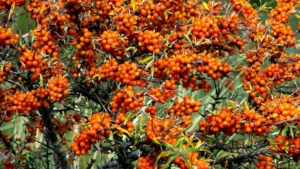Proanthocyanidins(PACs) are the most abundant polyphenols in human diets. Many studies have showed that PACs exhibit a wide range of effects, including anti-inflammatory, antioxidative stress, anti-arthritic, anti-cancer and regulation of glycometabolism and lipid metabolism. Considering their anti-oxidative and anti-inflammatory properties, PACs are expected to play a significant role in preventing retinal degeneration. In our study, sea buckthorn seed PACs protected retinal cells from visible light damage in vivo and enhanced the antioxidant enzyme activities, inhibiting proinflammatory cytokines, angiogenesis and lipid peroxidation. Protection may occur through these mechanisms.
Docosahexaenoic acid(DHA) is the most abundant polyunsaturated fatty acid(PUFA) in the retina; its high number of double bonds makes it the most easily oxidizable among retinal PUFAs. Light exposure causes the oxidation of retinal DHA in vivo, which has been shown to be the main source of reactive oxidation products that induce protein modifications in rod outer segments. Thus, the metabolism and resultant photo-oxidative damage in the photoreceptor cells is extremely high when exposed to high-intensity visible light.
 Studies on photochemical processes suggest that the eye is the most susceptible to visible light and UV radiation. The human retina is protected from high-energy UV light by the cornea and lens, which absorb UV light below 400 nm, but can be damaged by visible light. Therefore, retinal cells, particularly RPE and photoreceptors, are susceptible to injury caused by excessive exposure to visible light, which plays a role in the progression of age-related macular degeneration(AMD), as indicated in a human population-based study.
Studies on photochemical processes suggest that the eye is the most susceptible to visible light and UV radiation. The human retina is protected from high-energy UV light by the cornea and lens, which absorb UV light below 400 nm, but can be damaged by visible light. Therefore, retinal cells, particularly RPE and photoreceptors, are susceptible to injury caused by excessive exposure to visible light, which plays a role in the progression of age-related macular degeneration(AMD), as indicated in a human population-based study.
PACs, plant polyphenols formed by the polymerization of flvan-3-ols, as cytoprotective agents have become an important source in human health research. The maximum intake of PACs in various human populations can reach 400–450 mg/day. The average weight of an adult human is considered 60 kg. The sea buckthorn seed extract containing 38.9% PACs was used in this study.
Thus, the dose of 50 mg/kg sea buckthorn seed PACs used in rabbits could be considered a moderate dose. A human diet with foods rich in PACs, such as red wine, baking chocolate, apples and dried fruits, could reach dosages up to 700–800 mg/day of PACs, which would be about 100 mg/kg in rabbits using the body surface area(BSA) conversion. Thus, 100 mg/kg sea buckthorn seed PACs can be considered a high nutritional dose. Additionally, PACs and monomers could be detected in plasma as early as 0.5 h, and the maximal plasma concentration of these compounds was reached at about 2 h after ingestion.
Evidence has been presented that TNF-α, IL-1β and IL-6 play an important role in the regulation of inflammatory responses, and those cytokines elevation is associated with many inflammatory disorders. Proangiogenic factors have been shown to be involved in the development of AMD, with VEGF playing the most important role of neovascularization and increasing permeability. NF-κB plays a major role in the regulation of a wide range of genes (TNF-α, IL-1β and IL-6) that are involved in the underlying inflammatory diseases.
Epidemiological studies have indicated that populations that consume proanthocyanidin-rich foods have lower incidences of inflammatory diseases. PACs exert potent anti-inflammatory activity through the inhibition of TNF-α, IL-1β, iNOS and COX-2 by regulating the NF-κB and p38 MAPK pathway. In this study, sea buckthorn seed PACs decrease the levels of TNF-α, IL-1β and IL-6 in retina of rabbits exposed to visible light.
Human clinical studies show that total plasma antioxidant capacity is increased after oral administration of PACs, which provide a significantly greater protective effect against oxidative damage than vitamin C, vitamin E and β-carotene, because of the powerful antioxidant and free radical scavenging activities.
PACs could support indirect antioxidant effects via the regulation of enzymes that inhibit oxidants. Sea buckthorn seed extract pretreatment maintained the activities of GSH, GPx, SOD and CAT close to normal levels in vivo. Grape seed PACs inhibit UV-radiation-induced oxidative stress that inhibited the formation of H2O2, lipid peroxidation, protein oxidation and DNA damage in vitro. In the present study, sea buckthorn seed PACs attenuate the visible light-induced increase in retinal levels of MDA along with a marked increase of CAT and GSH-Px.
The biological effects of PACs are generally attributed to the smaller metabolites (valerolactones, phenylalkyl acids and small aromatics), which are extensively formed and readily absorbed from colonic breakdown of PACs. As the breakdown products of PACs, these metabolites may act as an important contributor to increased plasma antioxidant capacity and exhibit protective effects on retinal degeneration in this study.
In this study, PACs from sea buckthorn seed possess a protective effect against light-induced retinal degeneration through antioxidant, anti-inflammatory and antiapoptotic mechanisms. Supplementing with PACs may be a useful dietary approach to prevent AMD and other diseases related to retinal photooxidative damage.
Additionally, the gut-derived microbial metabolites of PACs are the main circulating forms in the blood and accumulation in the retinas. The efficacy of PACs is either via small molecular metabolite(s) and/or mediated by a distant upstream step in the defenses against light-induced retinal degeneration. Therefore, future studies are required to explore which specific forms of PC metabolites are active in the retina.

Leave A Comment